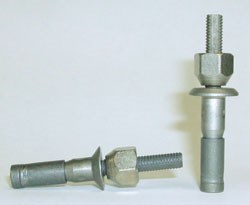Custom Collets Help Blind Bolt Shop Maintain Part Quality And Concenctricity
For their larger diameter fasteners, this manufacturer uses a custom-manufactured collet to control part quality and concentricity.
Monogram Aerospace Fasteners (Los Angeles, California) produces blind bolt technology for the aerospace industry. Blind fasteners (installed from one side of the structure) are an essential element of aircraft assembly because many fastening requirements present only one-sided accessibility, which precludes the use of conventional nut and bolt fastening.
Monogram’s Composi-Lok II blind bolt fastener is used to impart high clamping loads in composite airframe components, typically control surfaces such as flaps and ailerons, as well as metallic structure. This blind bolt overcomes damage to the composite structure by providing a large blind side upset, which allows the distribution of high bearing loads over a large area. The large blind side “footprint” permits the fastener to exert high clamp-up loads to the structure without damage to the composite. A locking feature ensures structural integrity under severe vibration. Used on both military and commercial aircraft, the Composi-Lok II is approved on more than 75 programs worldwide, including today’s most sophisticated aircraft designs.
Featured Content
For their larger diameter fasteners, Monogram uses a custom-manufactured collet from Hardinge (Elmira, New York) to control part quality and concentricity. The collet is hardened and ground and requires a quick open with a wide spread to go over the head of the nut (fastener body) and grip on the shaft beyond. Hardinge calls this style an “over-the-shoulder” collet. For added flexibility, this collet is designed with six slots incorporating an oval relief at each slot near the back bearing. The relief takes the stress of the wide spread and helps to maintain roundness at the back (bearing) of the collet. This particular collet has two head angles to allow maximum spread of the six collet leaves. The back drill area shown in the illustration accommodates the head of the nut.
According to Jeff Henry, vice president of manufacturing at Monogram Aerospace Fasteners, the company turned to Hardinge because of its reputation of quality and concentricity, as well as its cost advantage. “We’re drilling into some pretty hard material, cutting off to length, nosing the taper angle and tapping the fastener body using this collet, and we’re getting better than required results,” Mr. Henry says.
RELATED CONTENT
-
Femtosecond Laser Processing in the Medical Device Industry
Recent advances in the laser technology have brought improved capabilities for precision machining—no thermal effects and minimal post processing.
-
How Metallurgical Structure Affects the Machinability of Aluminum
Advancements in grain structure consistency and mechanical properties help to make this extremely machinable metal suitable for an ever growing range of applications.
-
Custom Tooling, Workholding Help Whip Rotors Into Shape
Whipple Superchargers uses unique form tools and dead-length-collet workholding for its B-axis turn-mill enabling it to create more accurate rotors for its brand of engine power-adders.







